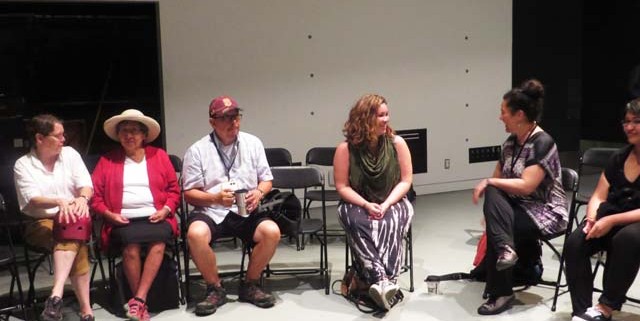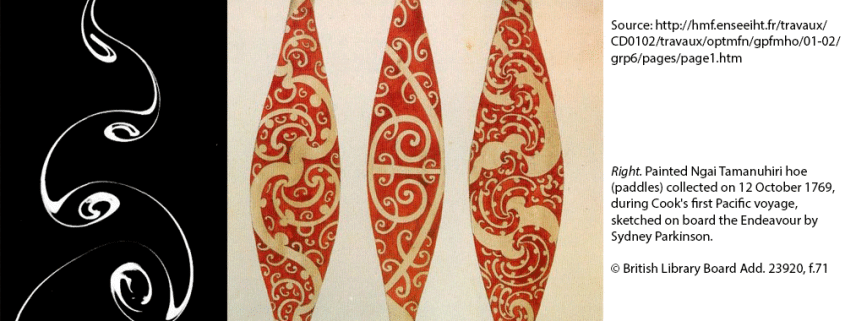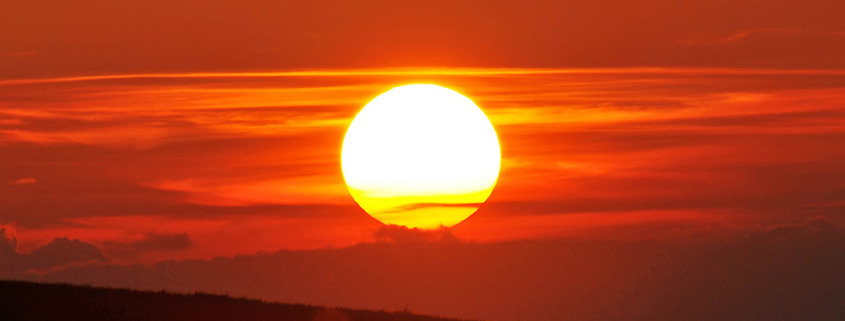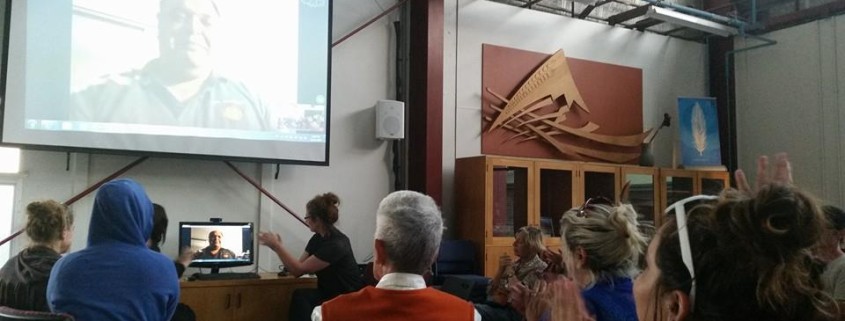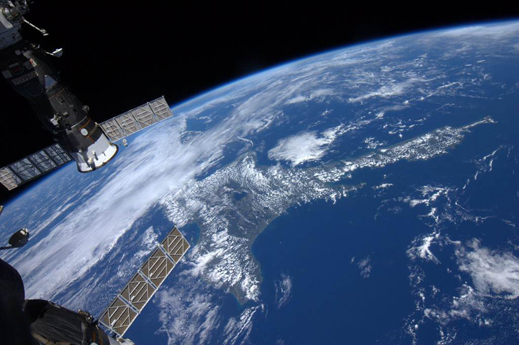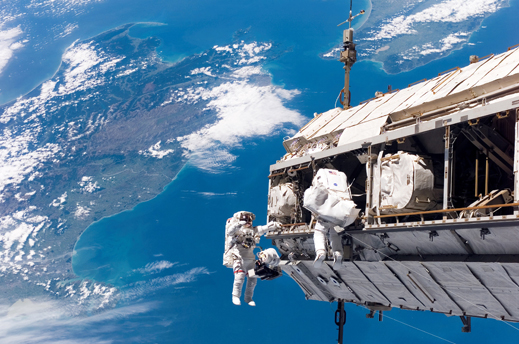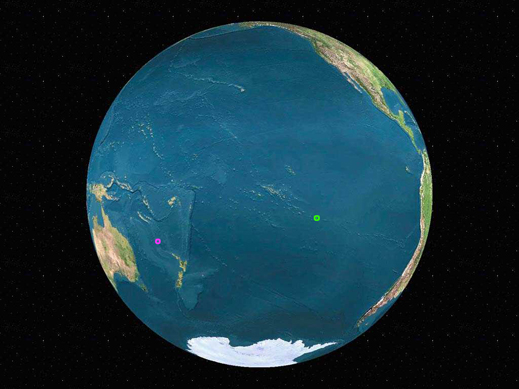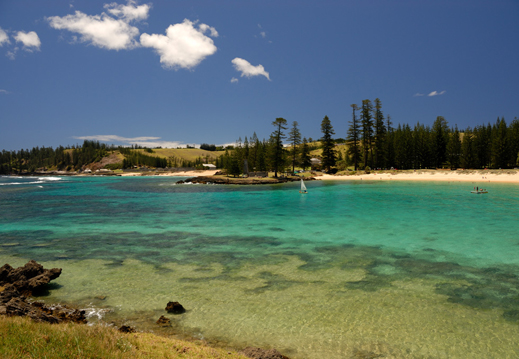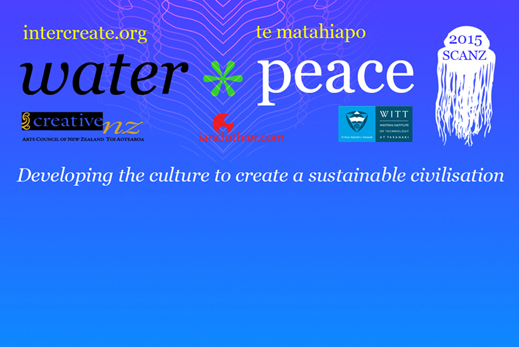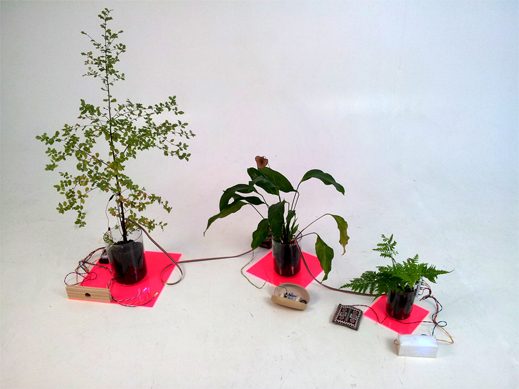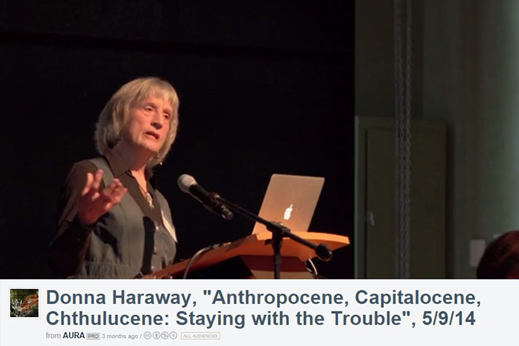News from Intercreate and associated organisations and individuals
The challenge to publicly funded organisations brought on by climate change
/in News /by Ian ClothierThis article looks at the issue of the arts and climate change, from the perspective of art and science. On the one hand, scientific knowledge about climate change is complete. However, actual change is slow.
In the context of the art world, it is clear we are living in a post modern world. Consequently, art is understood not solely for its inherent characteristics (the modernist view) but for the way art works interconnect with culture (the postmodern view).
So what we have in terms of art and science is the knowledge required and the cultural theory in place, but slow change and an art world largely disconnected from the issues of climate change. Why might that be?
This article is based on a presentation given to the Aotearoa Digital Artists 2014 symposium and I thank them for providing the context to bring these thoughts together.
Before I begin, following my work with tangata whenua (in particular Te Matahiapo) I will introduce myself by saying I am a hybrid Polynesian who comes from the sea. I live in Te Ika a Maui (the North Island of New Zealand).
I was born in Te Wai Pounamu (the South Island).
I have strong affiliations to Norfolk Island (pink circle) and Pitcairn Island (green circle). To island separate by vast swathes of Te Nui Moana a Kiwa (also called the Pacific Ocean). I say I come from the sea because it is the sea that connects these places.
My mother was born on Norfolk Island, and she met my father there in 1946 by swimming into him in Emily Bay – another reason I say I come from the sea.
Due to this heritage and the Mutiny on HMAV Bounty saga, I can whakapapa to Tahiti. This is important in some situations, particularly to tangata whenua.
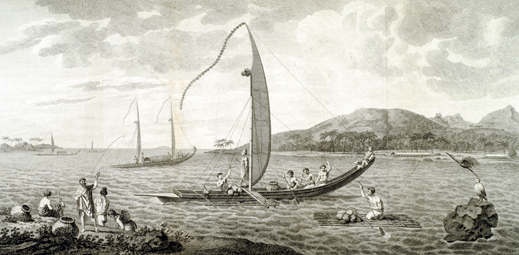
Matavai Bay (Tahiti) and Tahitian Boats. The source is Plate 2 of Volume 4 of John Hawkesworth’s Account of the “Voyages…in the Southern Hemisphere,” the official account of James Cook’s voyages, published in London in 1773. Source: http://libweb5.princeton.edu/visual_materials/maps/websites/pacific/cook1/cook1.html
I am also heavily involved in intercreate.org and particularly in the project SCANZ2015:water*peace. At Intercreate we often refer to the need to develop the culture of a sustainable civilisation.
And along with collaborators, I am an artist working in the electronic arts. Following is an image of the test set up for World Tree Ensemble: tiny_garden exhibited at grey ) ( area in Croatia. The work is by me and Andrew Hornblow.
Preliminary note
Firstly, I would like to acknowledge the many people with whom I have collaborated, the many thinkers, writers and artists who have influenced my own thinking.
Secondly, one of the many subjects under discussion today, is the idea of interdisciplinarity. While there are many projects and activities that are interdisciplinary, there are fewer articles that discuss ideas directly from an interdisciplinary perspective, so I thought this would be a good situation to see what both science and art have to contribute.
Consequently, this article will initially look at surfing and the characteristics of culture, then DNA and Plate Tectonics, followed by the culture around knowledge. Following from this will be a look at the creative and cultural sector in the context of work by Marina Abramovic and Ulay. Donna Haraway’s critique of the naming of the current geological era as the Anthropocene is then referred to, prior to a consideration of where responsibilities lie in this era of climate change.
1. Surfing and the characteristics of sub cultures
In 1976, Stephen Wayne Hull presented a sociological view of surfing culture which outlined the reason why surf culture could be distinguished as a distinct sub culture, in what we would call today a hybrid culture. The basis for this was that surfing had it’s own rules governing behaviour, specific terms and custom language, dress codes and preferences for certain types of food and creativity. I mention this here as language, collegiality, rules governing behaviour, dress and consuming food and genres of creativity apply to other sub cultures within society.
2. DNA, Plate tectonics and the culture of knowledge
There is a contrast between the development of scientific knowledge in regard to understanding the structure of DNA, and the acceptance of Tectonic Plate Theory.
While the long timeline of DNA manipulation can be traced to 9000 years ago in Mesoamerica with the selective breeding of maize, in modern genetics there was a crucial period between 1944 and 1953 when an accumulative sequence of research events resulted in Watson, Crick, Wilkins and Franklin identifying the double helix structure. The period prior to 1944 was referred to as “intellectual chaos” by Watson, as much research was being done in the dark: researchers had data but simply couldn’t understand how it all fitted together. It was only when Watson and Crick decided to try and build a model, that the structure was defined.
For many this story of the development of knowledge around DNA, carries an assumption that this applies across science: separate teams working in specialist laboratories incrementally resolve issues leading to a break through that is acknowledged in the field and subsequently society in a rapid progression. We shall soon see that this concept does not hold in all situations.
To both diverge and dovetail with the comments about culture and surfing, in the preface to Recombinant DNA which is cited above, James D Watson referred specifically to “a scrapbook like compilation of the largely sociopolitical events that occurred there” when discussing a 1975 conference on the guidelines for the use of recombinant DNA techniques, highlighting the non-data based associations around knowledge.
Indeed academic disciplines do use specific terms and language, have expected behaviours (going to conferences and reading journals, for example), collegiality, fairly rigid guidelines for presenting language and over coffee, it is likely that a preference for consuming certain types of food and creativity can be found (I mean here coffee, Jazz and Classical music). While academia does not have dress codes aside from predominantly covering up, these other traces of sub cultural profile indicate that science like other aspects of human activity, has a culture.
To return to the theme of the structural operation of scientific methodology, the theory of Continental Drift was first proposed by meteorologist Alfred Wegener in 1912, whose book The Origin of Continents and Oceans was published in 1915. This idea was not orthodox at the time, and as a result even though it was the right idea, the concept was completely dismissed. Wegener lacked an explanation for the forces required and had to battle the holders of orthodox ideology.
Then in 1929, Arthur Holmes suggested thermal convection for geological plates. Once again, this was dismissed by the majority of scientists and both were ignored until the 1960s. Anyone who has presented unorthodox ideas at symposia will understand the full force of antagonism that comes from challenging paradigms.
In 1962, Harry Hess published The History of Ocean Basins, outlining what became known as ‘sea floor spreading.’ In part this was a consequence of the use of radar in WWII and the development of marine geology afterwards.
Frederick Vine, Drummond Matthews and Lawrence Morley then confirmed spreading using electromagnetic field data around ocean ridges. John Tuzo-Wilson in 1965 proposed transform faults. The processes for drifting continents were then in place, and for much of the 1960’s an either/or situation was cited in textbooks. Through the 1970’s and 80’s a gradual transition took place, with new adherents finding positions of authority and transforming the taught ideology.
Consequently, there was a period of 50 years when the right ideas were ignored. Then there was a slow and generational transition toward acceptance. So why didn’t plate tectonics follow the DNA model of development?
One answer lies in the Watson’s reference to the conference on guidelines around recombination. Around a knowledge base, a community is formed. This community will have shared information sources such as reading the same journals and attending the same conferences. Friendships develop, based on shared views of the data. If the members of the community hold all the positions of authority in regard to papers and conference submissions, then this becomes the orthodox viewpoint. The greatest single factor in changing the orthodox viewpoint is a combination of accumulated knowledge and generational change as the adherents of old ideologies move on. This longer process appears to more adequately describe the development and acceptance of Continental Drift.
Consequently knowledge has points of connection to culture, in terms of the world view of the individual and the culture of the community around the knowledge. This contention may seem novel in some situations, however it is borne out in for example, the development and acceptance of Chaos Theory between the 1970s and the end of the millennium. This contention is also supported by a review of knowledge and nation (whose origin is in place, though this can be transported): Indian knowledge is indeed different from Chinese knowledge.
What I draw from this is that the culture of science simply was not ready for plate tectonics for 50 years. This can be seen in academia throughout the 20th century where the development of new ideas required older generations to move on, rather than the correct idea changing the beliefs of those holding the standing orthodox opinions. The aim here is not to bring doubt on scientific method but to elucidate the precise structure of that endeavour and the associated connections that arise in an analysis based in integrated systems.
I will now park this speculation on science and culture, and venture over to the creative sector, and look at what is going on there.
3. Creative and cultural sector
By the time they arrived for ANZART in Christchurch in 1981, Marina Abramovic and Ulay were renowned for their arrow piece The Other: Rest energy.
To experience Witnessing, the audience filed silently into the Great Hall of the Arts Centre, and formed a line around the perimeter of the room. In the middle of the space (but not the centre) Abramovich stood on a plinth and pointed to Ulay who stood on the floor. This work had a duration of three hours, and was typical of their endurance performances which placed physical tension and strain on the artists.
To fast forward to 2010, during Abramovic’s The artist is present Ulay appeared as one of the line of people who could spend some time and space with the now solo female artist. She sat at a desk in the middle of the space, and the audience lined up around the perimeter, to consider, photograph and contemplate the piece.
I am not here providing a critique of either art work, but rather drawing attention to the fact that the set up is almost exactly the same. The artist as central, the audience as viewers who are separated by space, behaviour and hierarchy. The centrality of the artist and a dichotomy between artist and viewer in a way that upholds hierarchies is typically Modernist in approach.
This is despite the art world shifting in ideological terms over this same time period, from Modernism to Postmodernism and on to the multicultural, hybrid, remixed, multiplicitous, media saturated, internet based, user generated type ideologies of the current era.
The song remains the same in the art world. The culture of modernism has not broken down as the primary adherents have not yet moved on in generational terms, and the practices of a lifetime persist. Once again the aim of this reflection is not to negatively critique the creative sector or the cited creative projects, but to elucidate the structures at play in and around the creative sector. As it happens, I quite like Abramovic’s work.
4. Donna Haraway and the anthropocene
In this video (particularly the first 3 minutes 25 seconds) Haraway is speaking on issues around the naming of the current geological era and when it should be considered to have commenced, where the discussion it seems likely will result in this geological period being known as the anthropocene. This is ironic, as she points out while critiquing the timing of the start of this period (called by some the Capitalocene). In putting forward a concept of Chthulucene, she provides a summary of contemporary intellectual and research based activity, one that is opposed to some of the values seen in the creative sector above, though which will be familiar to the community around the electronic arts.
In a framework based on the human impact on the Earth, Haraway declares: “I propose that it has become literally unthinkable to do good work in any interesting field with the premises of individualism, methodological individualism and human exceptionalism.”
Clearly there is for Haraway a dissonance between environmental discourses and creative approaches endorsed in the upper echelons of the art world such as the Museum of Modern Art (an institution for which I have some affection).
5. Responsibilities
To now draw all of this together, it is pertinent to ask: is the culture around art and creativity ready for sustainability?
There are many instances of artist driven initiatives on the environment (Caroline Robinson, Janine Randerson and Natalie Jeremijenko for example) and some instances of galleries and art organisations (the Govett-Brewster, Te Tuhi, and TheBigIdea.co.nz) but as a whole art institutions are supported and funded completely outside of a discourse on the environment. The contention I am making is that this not good enough, particularly for publicly funded institutions and organisations.
Changing culture possibly rates as the hardest task we can set ourselves, and the best way to do that is to start today.
What we really need is a kind of approach that doesn’t turn us all into policemen, carving society in two halves: the ‘correct’ and the ‘incorrect.’
Replicating the binary power structures of modernity will not assist us with the change that is sought. We need a culture that is inclusive.
We need to unite environmentalism and driving around in cars, in ways that reconstruct our relationship to the environment and builds a culture of sustainability. As electronic artists and educators yes there is a role to play here.
Just as it is important that humanity engages with the environment, it is likewise important that governments and organisations do likewise, along with the organs of government and projects funded by central, regional and local bodies.
In some sense the lack of resolution of climate change problems is driving us to a position whereby soon there will be no choice: we will have to, for the sake of our own survival.
64% of electronic arts professionals think their engagement with the environment will increase in the next five years
/in News /by Ian Clothier
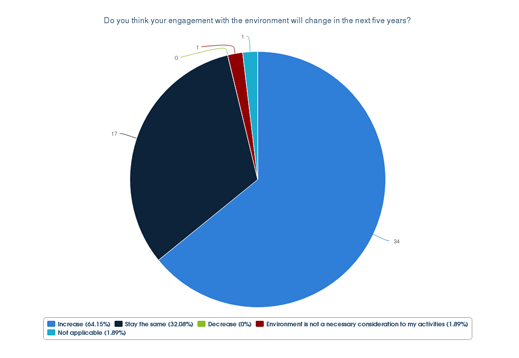
Survey question 8: Do you think your engagement with the environment will change in the next five years?
In a recent survey on the future of electronic arts undertaken by Intercreate, 64% of respondents indicated they believe their engagement with environmental issues will increase in the next five years. This is a striking statistic and indicates a rising level of concern among artists, for the environment.
Electronic artists most frequently use circuits, digital and computer technology in their work, but rather than the somewhat prejudiced view of geeks and hackers working all hours in technological bunkers, a considerable portion of the electronic arts community is concerned with the very real world issues of the human relationship to the environment. While this may have been speculated previously, the survey results confirm the speculation.
The survey was intended to measure attitudes about a range of issues, among the core group of participants and audience around Intercreate.org and it’s Aotearoa-New Zealand based Intercreate Trust. While most respondents (62%) were artists, a further 32% identified themselves as a Creative or Cultural Sector professionals.
This is the first survey of it’s type conducted by Intercreate, and further are likely at regular intervals, to track changing trends in the electronic art sector. Data from the inaugural survey is still being processed and it will be several months before the full analysis is complete.
SCANZ2015 confirmed dates
/in 2015 Schedules, Featured, News /by Ian ClothierDates for SCANZ2015:water*peace have been confirmed, with participants arriving on the 17th of January 2015 and departing on February 2nd 2015.
The first night will be spent in Nga Motu New Plymouth so that participants can travel by van and car to Parihaka, leaving around 8am on Saturday the 18th. As a special feature of SCANZ 2015, we will be staying overnight. We return to the WITT campus on Sunday afternoon, for a first meet up at the WITT campus.
The final weekend of SCANZ occurs on the 31st of January and the 1st of February 2015 with participants departing on Monday the 2nd of February.
media art project selected
/in News /by Ian Clothier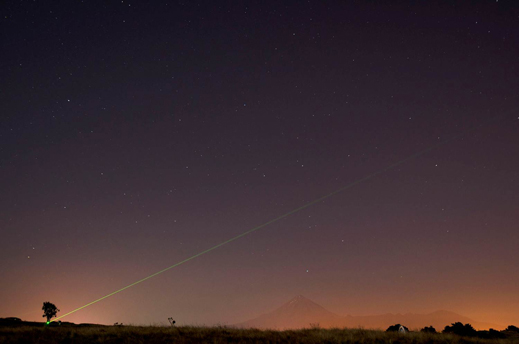
This image of the laser being tested was taken during the SCANZ residency in January and February 2013 (photo by Kalya Ward)
Laser Karakia Artwork Selected as Media Art Project 2014
A project that utilises laser light technology to carry sound has been selected as the Intercreate Media Art Project 2014. Ko Tatou Te Tangata by Stuart Foster and Kura Puke, with Dr Te Huirangi Waikerepuru and Te Urutahi Waikerepuru, will employ oscillating lights to carry both the human voice and environmental sounds.
The technology was tested at SCANZ, an artist residency held at WITT in New Plymouth earlier this year. Laser beams were sent to a light receptive panel that had speakers connected. The result was that waiata, karakia, karanga and sounds of moving water were transmitted. For the SCANZ project, the karakia was contributed by kaumatua Dr Te Huirangi Waikerepuru with the tangata whenua, Ngāti Tawhirikura.
Kura Puke (Tapuke) has whakapapa to the hapu of Katere ki Te Moana marae, which extends from the clifftop at Fitzroy, to Te Rewa Rewa Pa on the coastal walkway. Both Puke and Foster are lecturers at Massey University Wellington, while Te Huirangi Waikerepuru and Te Urutahi Waikerepuru direct Te Matahiapo Research Organization based in New Plymouth.
For the Media Art Project they wish to deepen the engagement with tangata whenua and locals, and investigate how to “transform an environment often seemingly subsumed by commercial industry into an awareness of the dynamic layered diversity of the land” which involves embracing “the intangible and the unseen energies” to inquire into and visualise ideas about, wairua (essence), mauri and the virtual.
As the commissioner of the work funded by the Arts Council of New Zealand we are extremely pleased with the calibre of the project, and the way advanced technology is integrated with the local environment, local community groups and customary Maori knowledge.
Background to the project
Intercreate Trust is based in New Plymouth and Auckland, with head office in New Plymouth. Funding was received from the Arts Council of New Zealand to commission a project that inspired “artists and creative teams to think boldly about combinations of cultural ideas and contemporary media technologies, that could be implemented in public space and/or Pukekura Park in New Plymouth. The projects are likely to involve working with local groups.” A second project is under consideration.
The selection process involved blind review, where the selection panel does not know the names of the people applying. While the applicants submit a CV, the CV also doesn’t mention names.
The panelists were: Chris Connolly, Pukekura Park curator; Nina Czegledy, who is the Intercreate International Research Fellow; and Australian based curator Leah Barclay. Intercreate’s Executive Director was not on the panel and ensured names were omitted from the applications, prepared the applications for review by the panel and also collated the panel responses. Rhana Devenport was on the selection panel until she left for Auckland, as was Anna Carrington until her move to Wellington.
Artists full statement
In their application, the artists Puke and Foster stated that “this trans-disciplinary collaboration hopes to contribute to innovative knowledge transfer with the tangata whenua, and to offer an experience that may deepen the engagement of local people and visitors through inclusive visual-aural ceremonial and relational events. They also wish to investigate, through social encounter and art-design culture, how to transform an environment often seemingly subsumed by commercial industry into an awareness of the dynamic layered diversity of the land which involves embracing the intangible and the unseen energies to inquire into and visualise ideas about, wairua (essence) mauri and the virtual.”
Useful links
Intercreate page describing the project and how to apply
http://www.intercreate.org/media-art-projects/
Artist links
Kura Puke
Stuart Foster
Te Huirangi Waikerepuru and Te Urutahi Waikerepuru
Maori translation and dictionary site
http://www.maoridictionary.co.nz/
WITT (Western Institute of Technology at Taranaki) site of SCANZ residency where technology was tested by the artists
http://www.witt.ac.nz/
Creative New Zealand Toi Aotearoa The Arts Council of New Zealand, funder of the MAP 2014 project
http://creativenz.govt.nz/
Like us on Facebook
Follow us on Twitter
Exhibitions + Projects
/in News /by Ian Clothier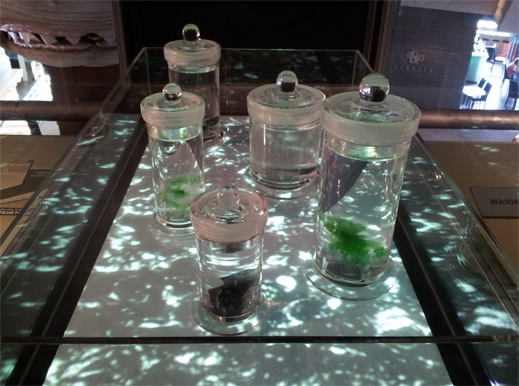
Iwasaki, Hideo cultures cyanobacteria which then photosynthesise according to the light of the moving image work projected from below (from the 3rd nature exhibition
Intercreate.org projects and exhibitions
This page has introductory information about Intercreate.org projects, which include our biennial project SCANZ, exhibitions in Albuquerque, Istanbul, Rio and in Aotearoa New Zealand.
Upcoming
We are currently working on exhibition projects for Sydney, Albuquerque and Taos and Nga Motu New Plymouth. SCANZ 2015 will be themed Wai (water) and Peace, two significant issues facing humanity.
SCANZ 2013: 3rd nature exhibition

‘The electromagnetic sensory world of sharks’ by Mike Paulin, a Zoologist was projected onto the mesh of a ‘sail’, in the galleries which houses traditonal Maori artefacts.
3rd nature at Puke Ariki integrated museum and library. To see works in the 3rd natureshow, click the image above.
Wai (for ISEA 2012 Albuquerque)

Te Urutahi Waikerepuru, Dine’/Navajo musician Andrew Thomas and his partner, Te Huirangi Waikerepuru, myself, Johnson Dennison, Gordon Bronitsky and Rosemary Dennison just before the ceremonies started.
Water is essential for life, sacred to many indigenous peoples worldwide and endemic to natural processes. This project connects Maori cosmology, notions of integrated systems, Western art and science in order to reinvigorate our understanding of flow and water. The project reiterates the urgent need to engage with sustainable practices given climate change. It also underlines the importance of listening to the indigenous voice on the environment.
The Wai (Maori for water or flow) project uses technology to connect distant spaces and cultures around the theme of water. Water holds significance for Maori of New Zealand Aotearoa, Navajo/Dine in New Mexico and neighboring regions, and is essential to survival. Isleta Pueblo, Navajo/Dine and Maori ceremonies will be performed as part of the dawn opening for the exhibition.
The project is led by Te Huirangi Waikerepuru and curated by Ian Clothier. It will open September 19th at 516 Arts in Albuquerque. A collective of people spanning four countries and many cultures – Aotearoa New Zealand, USA, Australia, India and representatives of indigenous peoples -are presenting an interconnected project. The collective is known as Te Hunga Wai Tapu (the people for whom water is sacred).
For more information about Wai, check Wai exhibition and Wai participants.
Te Kore Rongo Hungaora Uncontainable Second Nature
Te Kore Rongo Hungaora Uncontainable Second Nature was a project of ISEA 2011 Istanbul. A travelling version has since been formed, for exhibition in Rio de Janeiro.
The exhibition crosses cultural and discipline boundaries. The location of five themes from within European and Maori world views, provides a framework with which to construct a cultural bridge between Maori and European of New Zealand. Culture is usually presented separated and distinct; given the intercultural bridge, works from art and science are recontextualised as cultural texts symbolic of belief systems. Discipline is not fixed, but fluid in a transformational environment. In the exhibition, digital and post-digital exist in a state of hybridity.
Curated by Ian Clothier with an advisory panel of Nina Czegledy, Trudy Lane and Tengaruru Wineera, for ISEA 2011 Istanbul. Supported by:
Exhibited works
Please see here for a list of all the projects involved in the exhibition »
Exhibition Venues
Event: ISEA 2011 UNCONTAINABLE
Venue: Cumhuriyet Art Gallery, Istanbul, Turkey
Dates: September 14th – October 12th, 2011
Exhibition Page: Uncontainable: Second Nature
Related Event: Eco sapiens Round Table
Event: CulturaDigital.Br International Festival
Venue: Rio de Janeiro, Brazil
Dates: December 2nd–4th, 2011
Exhibition Page: Rongo Hungaora: Second Nature [Travelling]
inter / place
The works in the exhibition inter/place present an attempt to come to grips in some way with the notion of multiplicity and a sense of distributed identity. Rather than gather all the artworks up in one area and present them as a selection of works on one theme, the artists taking part in this exhibition have been free to create their own work and explore different exhibition locations for that work. Subsequently none of these works have been placed in the conventional sites for exhibitions in Puke Ariki museum. There is no claim to novelty in this approach but rather the determination that a view based on distributed and multiple identity has been hybridised to the Puke Ariki location.
Venue
Puke Ariki – three works in the museum section and one in the library.
Date: December 2 2010 – February 3 2011.
A link to the catalogue is provided below.
Like us on Facebook
Follow us on Twitter
Intercreate.org is proudly powered by WordPress

